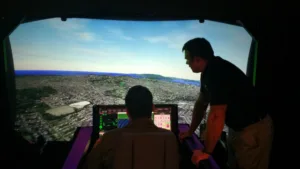JVC’s VS2500 is the company’s e-shift 4K projector, which means it use a trio of 1920×1080 resolution LCOS imagers and an image shifting optic to create a “4K like image.” JVC admits the quality is not as good as a native 4K imager projector, but is in between 1080 and 4K. This unit is unchanged from last year and was shown running at 120 fps using two input channels from a Vital 1000 IG over HDMI.
The other product on display was the VS4500 which uses a trio of 0.69” native 4K LCOS imagers. This projector was debuted at CEDIA as model RS-4500 (see JVC Launches Native 4K Projector at CEDIA). It is not clear if there are any major differences between the two models.
At I/ITSEC, it was shown running at 120 fps using a Rockwell Collins EP8100 IG with a single input over DisplayPort 1.2a. This unit has been upgraded to 3000 lumens using a new Gen.2 BluEscent laser phosphor engine. In the Gen.1 engine, there were two banks of 8 blues lasers illuminating a spinning laser phosphor wheel. In the Gen. 2 design there are 6 banks of 8 blue lasers illuminating a static laser phosphor disc. This is liquid cooled and there are inorganic binders for the phosphor to maximize lifetime. Lifetime is rated at 20K hours at rated brightness or 40K hours at half brightness. The design has helped reduce noise and is more rugged for the simulation market.
However, the most impressive demo was a projector with a trio of native 8K LCOS imagers. This is still a prototype, but it was shown in the CRVS (Constant Resolution Visual System) simulator segment in the Boeing booth. This projector now allows for 20/20 vision over the full screen – or, to put it another way, eye limited constant resolution. Boeing has already deployed about 70 of the CRVS systems using JVC 4K native or 8K e-shift projectors and now wants to show what 8K native looks like, and enable an upgrade if desired.
According to Boeing’s Harry Streid, the IG can’t quite deliver a fully texture 8K image. It can deliver 8K polygon edges, but the texture resolution is somewhat less. He said this is mainly a limitation of the GPU memory which was 8GB. To do full texture 8K at 120 fps will require 32 GB of GPU memory.
The image quality was superb with no aliasing in fine diagonal lines – an area where e-shift projector can create artifacts. The contrast and sharpness of the image was also quite apparent in the fine details of the synthetic San Francisco buildings using in the demo. – CC

